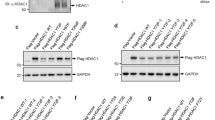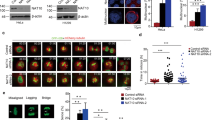Abstract
Histone modification through acetylation and deacetylation is a key process in transcription, DNA replication, and chromosome segregation. During mitosis, histones are highly acetylated and chromatin is condensed. Here, we investigate the mechanistic involvement of histone deacetylase (HDAC) activity in the regulation of mitotic checkpoint activation. Inhibition of HDAC activity was found to cause the improper kinetochore localization of the mitotic checkpoint proteins, and to prolong mitotic arrest, and thus to lead to chromosomal instability due to aberrant exit from the mitotic cell cycle arrest. In addition, treatment with HDAC inhibitor attenuated the activations of p38 and ERK kinases, and increased the expression levels of cIAP-1, suggesting that the observed increased adaptation and chromosomal instability induced by inhibiting HDAC activity might be directly connected with the activations of cell survival and/or antiapoptotic signals. Moreover, the treatment of cells with mitotic defects with HDAC inhibitor increased their susceptibility to chromosomal instability. These results support the notion that HDAC activity plays an important role in the regulation of mitotic checkpoint activation, and thus the aberrant control of HDAC activity contributes to chromosomal instability.
This is a preview of subscription content, access via your institution
Access options
Subscribe to this journal
Receive 50 print issues and online access
$259.00 per year
only $5.18 per issue
Buy this article
- Purchase on Springer Link
- Instant access to full article PDF
Prices may be subject to local taxes which are calculated during checkout




Similar content being viewed by others
References
Amato SF, Swart JM, Berg M, Wanebo HJ, Mehta SR and Chiles TC . (1998). Cancer Res., 58, 241–247.
Amon A . (1999). Curr. Opin. Genet. Dev., 9, 69–75.
Cahill DP, Lengauer C, Yu J, Riggins GJ, Willson JK, Markowitz SD, Kinzler KW and Vogelstern B . (1998). Nature, 392, 300–303.
Chan GKT, Jablonski SA, Sudakin V, Hittle JC and Yen TJ . (1999). J. Cell Biol., 146, 941–954.
den Elzen N and Pines J . (2001). J. Cell Biol., 153, 121–135.
Ekwall K, Olsson T, Turner BM, Cranston G and Allshire R . (1997). Cell, 91, 1021–1032.
Geley S, Kramer E, Gieffers C, Gannon J, Peters JM and Hunt T . (2001). J. Cell Biol., 153, 137–148.
Gorbsky GJ . (1997). Bioassays, 19, 193–197.
Hunt T, Luca FC and Ruderman JV . (1992). J. Cell Biol., 116, 707–724.
Kallio MJ, Nieminen M and Eriksson JE . (2001). FASEB J., 15, 2721–2723.
Krebs JE, Fry CJ, Samuels ML and Peterson CL . (2000). Cell, 102, 587–598.
Kruhlak MJ, Hendzel MJ, Fischle W, Bertos NR, Hameed S, Yang X-J, Verdin E and Bazett-Jones DP . (2001). J. Biol. Chem., 276, 38307–38319.
Lengauer C, Kinzler K and Vogelstein B . (1998). Nature, 396, 643–649.
Li W, Lan Z, Wu H, Wu S, Meadows J, Chen J, Zhu V and Dai W . (1999). Cell Growth Differ., 10, 769–775.
Lieu CH, Liu CC, Yu TH, Chen KD, Chang YN and Lai YK . (1998). Cell Growth Differ., 9, 1097–1106.
Minn AJ, Boise LH and Thompson CB . (1996). Genes Dev., 10, 2621–2631.
Pihan GA and Doxsey SJ . (1999). Semin. Cancer Biol., 9, 289–302.
Rieder CL and Salmon ED . (1998). Trends Cell Biol., 8, 310–318.
Saitoh H, Tomkiel JE, Cooke CA, Ratrie HR, Maurer M, Rothfield NF and Earnshaw WC . (1992). Cell, 70, 115–125.
Shen SC, Huang TS, Jee SH and Kuo ML . (1998). Cell Growth Differ., 9, 23–29.
Sudakin V, Chan GK and Yen TJ . (2001). J. Cell Biol., 154, 925–936.
Takenaka K, Moriguchi T and Nishida E . (1998). Science, 280, 599–602.
Taylor ST, Ha E and McKeon F . (1998). J. Cell Biol., 142, 1–11.
Taylor SS and McKeon F . (1997). Cell, 89, 727–735.
Wang TH, Wang HS and Soong YK . (2000). Cancer, 88, 2619–2628.
Wassmann K and Benezra R . (2000). Curr. Opin. Genet. Dev., 11, 83–90.
Acknowledgements
We thank Dr Frank McKeon and Dr William Earnshaw for providing materials. This work was supported by POSCO (3PD0101301) and a research grant from the National Cancer Center.
Author information
Authors and Affiliations
Corresponding author
Rights and permissions
About this article
Cite this article
Shin, HJ., Baek, KH., Jeon, AH. et al. Inhibition of histone deacetylase activity increases chromosomal instability by the aberrant regulation of mitotic checkpoint activation. Oncogene 22, 3853–3858 (2003). https://doi.org/10.1038/sj.onc.1206502
Received:
Revised:
Accepted:
Published:
Issue Date:
DOI: https://doi.org/10.1038/sj.onc.1206502
This article is cited by
-
Dietary phytochemical PEITC restricts tumor development via modulation of epigenetic writers and erasers
Scientific Reports (2017)
-
High throughput screening identifies modulators of histone deacetylase inhibitors
BMC Genomics (2014)
-
Cancer-associated alteration of pericentromeric heterochromatin may contribute to chromosome instability
Oncogene (2012)
-
Deacetylation and methylation at histone H3 lysine 9 (H3K9) coordinate chromosome condensation during cell cycle progression
Molecules and Cells (2011)
-
Mitotic catastrophe is the predominant response to histone acetyltransferase depletion
Cell Death & Differentiation (2009)



